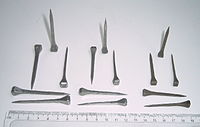Hoof nail
Nails are provided for connection of the horseshoe to the hoof serving, made of wrought iron nails . There are also horseshoe nails made of copper with an anti-microbial effect.
Horseshoe nails have a length of about 41 to 80 millimeters, their strongly conical shaft has a rectangular cross-section four to five millimeters wide and one to two millimeters thick and a slender head extending from the shaft. The tip has a laterally bevelled pinch.
The head is conical, shaped like a pyramid . When hammering in, the tip of the nail emerges from the side of the hoof so that it can be bent into rivets and the horseshoe can be held more firmly.
Complications
When the hoof nail injures the dermis of the hoof, what is known as nailing can occur.
Trivia
- In the 13th century Freidank wrote his work , which was very popular until the 16th century, Modesty , a collection of rhyming sayings. The following proverb is conveyed therein:
I hear those who know say:
'a nail keeps an îsen,
an îsn a ros, a ros den man,
a man a burc who strîten kan,
a burc a lant betwinget,
daz ez, after gracious things.
the nail is wol bewant,
who helped îsen, ros, man, burc and lant
such êrn,
dâ from sîn name sô hôhe stât.
- The motif of the missing horseshoe nail with the subsequent loss of the horse can also be found in Ludwig Aurbacher's "Story of the Rider and His Horse" , which appeared in 1834.
- The nail was included in the fifth edition of Grimm's Fairy Tales in 1843 and refers to Freidank.
- The following well-known English proverb is found in "What Katy did" by Susan Coolidge in 1872 :
For the want of a nail the shoe was lost,
For the want of a shoe the horse was lost,
For the want of a horse the rider was lost,
For the want of the rider the battle was lost,
For the want of the battle the kingdom was lost,
and all for the want of a horse-shoe nail.
- In 1925, the head of the army command of the Reichswehr, Hans von Seeckt, put the so-called Hufnagelerlass (RH 1/85 - Reichwehrdienstvorschrift 1/85) into force, which caricatured the excessive bureaucratization of official processes .
Individual evidence
- ↑ Hufnagel , pl-huftechnik.eu
- ↑ Kupfernagel , pl-huftechnik.eu
- ^ Freidank's modesty , HE Bezzenberger, Halle, 1872, page 139
- ^ [1] , Ludwig Aurbacher, JG Cotta, 1834
- ↑ Der Nagel 1843 , wikisource
- ^ What Katy did , Susan Coolidge, 1872

